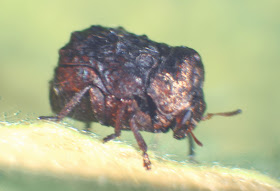
We recently looked out our patio sliding glass door and saw this juvenile Cooper's hawk sitting on our bench 6 feet from us. It wasn't bothered by us, more intent on our bird feeders which had been hosting a bunch of English sparrows.
 |
Cooper selecting dinner
|
With Barb's 90+ species of native plants in 1/10th of an acre backyard, we have a wide variety of food choices for birds. In addition to the seeds of flowers and shrubs, there are all the pollinators, butterflies, bees, beetles and other insect species climbing on the flower heads. This and our bird-feeders provides a cafeteria for birds ranging from hummers to bluejays and mockingbirds. There are also chipmunks and skinks scurrying along the ground to catch the eye of our diligent hawk.
Cooper's are model fathers, building the nest, feeding the female while nesting and then bringing baby food for the nestlings before they fledge the next month. What is not to love about a daddy like that!
It's a bird-eat-bird world out there as seen in our neighbor Cyrus Taylor's backyard video of the Cooper's dining alfresco, munching and spitting out the feathers of an unknown bird.
We humans are the apex predator on our planet. Now we are faced with picking winners among the smaller species. By taking down our bird feeder we may slightly lessen songbird mortality. On the other hand, there are still the chipmunks and baby rabbits. A Cooper has a family to feed, hopefully choosing English sparrows. In the long run, it is still a bird-eat-bird world.
More on Cooper's Hawks at this
MDC Field Guide link.
++++++++
An interesting side note, the name Cooper's Hawk is part of a debate in the birding world. As described here, the American Ornithological Society is changing the names of several birds because the name is associated with Confederate officers and/or slave owners of the Civil War period. Who was Cooper?
"He
was an American naturalist born in 1798 and one of the original officers
of The New York Academy of Sciences. He was a man of “exceeding
modesty,” according to a written history of the academy. “Over cautious
in naming new species, he generously permitted others to use his
material and sometimes to gain the credit that might have been his.”
As one member says, “I just find it a little bit excessive. It’s one thing to take down
statues of Southern Civil War generals and outright racists,” he said.
It gets even more complicated. The Audubon Society is named for John James Audubon, a well-known early American birdwatcher and a wildlife
artist during the 1800s who created “The Birds of America,” a collection
of 435 life-size prints of various bird species.
"He also was a slave owner who opposed emancipation and was accused of
academic fraud and plagiarism, stealing human remains and sending human
skulls to “a colleague who used them to assert that whites were superior
to non-whites,” according to the National Audubon Society." Sun Times
This is all part of a slippery slope, acknowledging our past society sins without totally ignoring the achievements of the "sinners". To me, it raises the obvious question, "who is next?"





.jpg)










.JPG.jpeg)






.jpeg)
.jpeg)
.jpeg)
.jpeg)
.jpeg)
.jpeg)












_-_Guelph,_Ontario.jpg)










